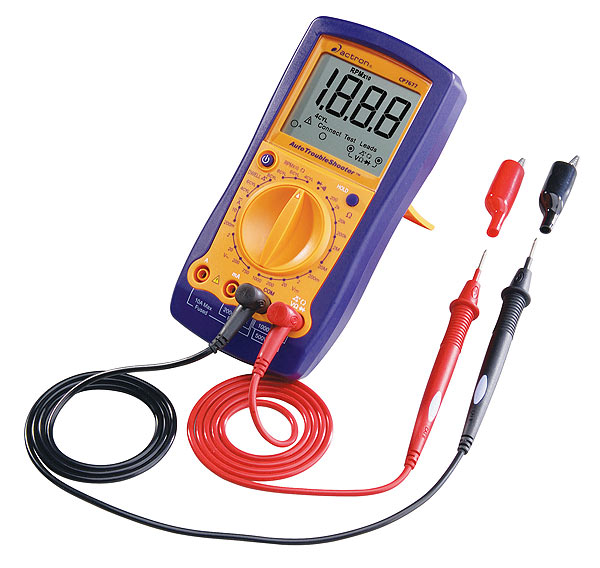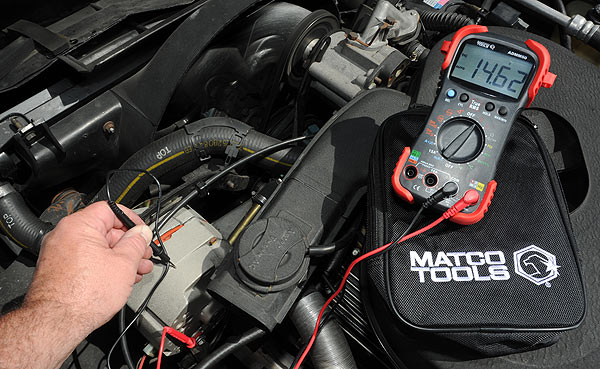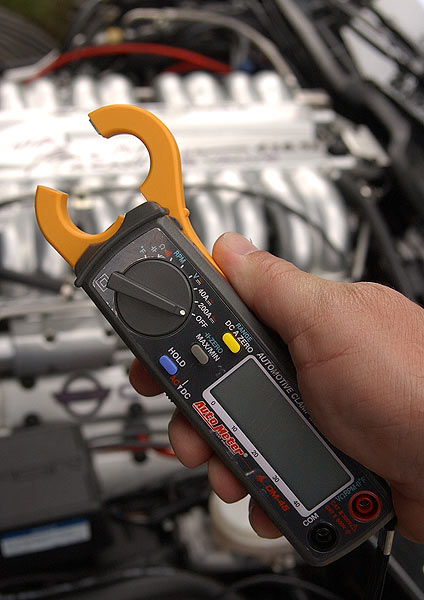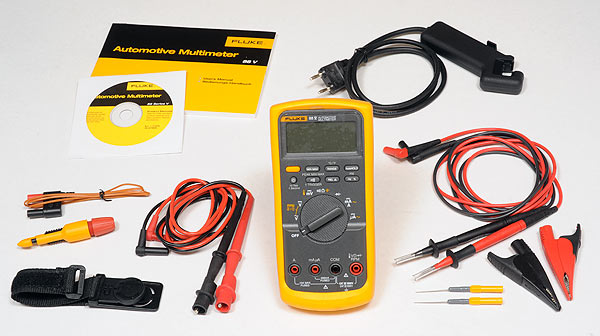A Dose of Digital: Part 2 - Diagnostic Tool Buyer's Guide - Page 2 of 4
 |
 |
© 2011 by Hib Halverson
No use without permission, All Rights Reserved
![]() Discuss this article
Discuss this article
Hot Sparks
Engine controls diagnosis may require testing spark output. The crude way is to pull a plug wire, hold it close to ground and crank the motor-careful to not get shocked! Better to use a spark tester.
The ST125 was developed decades ago by GM's old AC Spark Plug Division and is still sold today by GM's special tool supplier, Kent-Moore, as PN J-26792, but has been copied by many tool makers. The Kent-Moore tool, along with K-D Tools' version sold by Matco (PN KD2756) and others have air gaps requiring about 25,000-volts output. Some ST125 rip-offs aren't manufactured properly and don't have the right gap for use with modern ignition systems, so buyer beware. To use this tool, clip it to a ground, connect a plug wire to the tester then crank the engine. If the spark jumps the gap, the secondary ignition system on a stock or near stock engine has adequate output for the cylinder in question. There are adjustable gap testers, too, such as Kent-Moore's J-41321 or the Thexton 404, which simulate gaps requiring coil output of 10-40kV.
Another Waekon product we tested was the "kV/Arc Quick Probe" (PN 76760) which assists in finding faulty plugs, plug wires, cap, rotor and coils. It uses a capacitive sensor to detect each spark. Place the Quick Probe over the ignition wire. Each time it detects a spark, its LED flashes, indicating sufficient spark duration. Press the button and the unit's LCD displays peak voltage. The kV/Arc Quick Probe is available from Matco Tools and other vendors.
Meters
Now, we're getting to the meaty stuff. Multimeters are pieces of equipment capable of multiple measuring functions. Basic units combine an ammeter, voltmeter, and ohmmeter.
Analog multimeters, sometimes called "volt-ohm meters" (VOM), once were the standard in automotive work. In fact, we still have a classic "Simpson 260" VOM in the shop which I bought when I was a teenaged brat just starting in service work. We still use it, mainly to impress C1/2/3 Luddites on how retro we can be...just kidding. In reality, there are still applications for VOMs. One thing they do well is display the rate of change in voltage or current fluctuations. Also, some believe analog meters are less susceptible to radio-frequency interference.
Today, "digital-multimeters" (DMM) are the norm and every DIY doing engine controls diagnosis should have one. A key DMM specification is input impedance, the resistance applied to the circuit being tested, which must be a minimum of 10 Megohms (10,000,000 ohms). Also important is the unit's function set. Good DMMs not only measure voltage, current and resistance, but should also measure duty cycle and rpm. Additionally, the DMM you buy needs to be built with a robust case and selector switch and include a set of leads which use cables and clips built well-enough to last a number of years. Finally, shop use can sometimes be tough on DMMs, consequently, it needs a "boot"-a sheath of hard rubber material which surrounds the meter or at least covers the corners. The boot protects the tool if you drop it or it bangs against part of the car.
If you can afford them, valuable DMM options are data recording ability, a "sample and hold" feature (temporarily stores readings for viewing after the device is removed from the circuit) and temperature measurement capability.
We looked at several DMMs. While there are cheaper units, an example of what we think is an an entry-level-minimum for Corvette diagnostic work, is the Actron CP7677. It offers standard DMM functions, along with AC voltage measurement, rpm and a hold feature. The CP7677 includes a protective rubber boot and a fold-out stand. It is a solid choice for cost-conscious DIYs street-priced at about $60. The main drawback of the Actron is that it doesn't support RPM measurement by inductive pick-up which can limit it when trying to get RPM on Corvettes with distributorless ignition systems, ie: the second generation ZR-1 and anything newer than 1997.
A DMM which has an inductive pick-up, an excellent feature set and a reasonable price is the Matco ADMM 50. This unit is also the least expensive DMM we tested which reads "true RMS" voltage when measuring alternating current. A full explanation of the difference between averaging voltage measurements of a wave form and taking a true RMS voltage measurement would take more space then we have available in this section of our article. Suffice to say that a DMM capable of true RMS voltage measurements of AC current is more accurate.
We spent a couple of weeks testing the Matco and found it simple to use, easy to read and, not only can it sense RPM inductively, but it has temperature measuring capability, a hold feature and, by virtue of a black and red exterior, is kinda cool looking. Matco prices this unit at 155 bucks and it's a darn good choice if you want to balance cost, a full-feature set and true RMS measuring ability.
The Auto Meter DM-46 stands-out because it combines many features-including a built-in, inductive clamp for current measurement, the ability to read frequency and capacitance and true RMS measurement of AC voltages-into a uniquely-sized package smaller than most DMMs. The DM-46's diminutive size, its function set and accuracy makes it our choice when we need a multimeter on a test trip but we can only carry a small tool bag-often the case when traveling by Corvette. Amazon.com has it for about $260.
Fluke is one of the world's preeminent makers of electronic test equipment, including DMMs. Specific to automotive work are the 88 V/A and the new, award-winning 233A. The 88 V, is considered by some to be the "Cadillac" of DMMs for automotive service work-in fact, it is sold to Cadillac and other GM dealers by Kent-Moore as J-39688. The full-featured Fluke is a favorite for its traditional DMM size and appearance, ease-of-use, accuracy, reliability/durability, wide range of functions and a limited lifetime warranty. Four features put the Fluke 88 V solidly in the professional category: true RMS capability, temperature measuring, a peak/average recording feature and a bar graph display to represent changing or unstable signals. The Fluke 88 V is street-priced at Amazon.com at $300 for the basic DMM or $450 for the 88 V/A which bundles the DMM with a number of accessories specific to automotive work. If you want Fluke quality and accuracy, but balk at those prices; one of the general-purpose Flukes, the 115 priced at about $130, has a minimum automotive feature set and, with a test lead upgrade, can read RPM.
Fluke's newest full-featured, automotive DMM is the 233/A. Obvious is its revolutionary, remote display module which, when separated, is connected by a radio link to the 233's main body. This handy feature is ideal when you want to take your measurements at a distance. For example, say you want to measure a voltage in the wiring harness at the rear of the car but, to get the measurement, you have to step on the brakes. You can sit in the driver seat with the 233/A display in your hand while measuring a voltage at the rear of the car. The Fluke 233 is also good for road testing. Say you want to measure alternator output while driving. You can do it with the 233/A by connecting the test leads, securing the lower section of the 233A under the hood, then taking the display head into the cockpit with you.
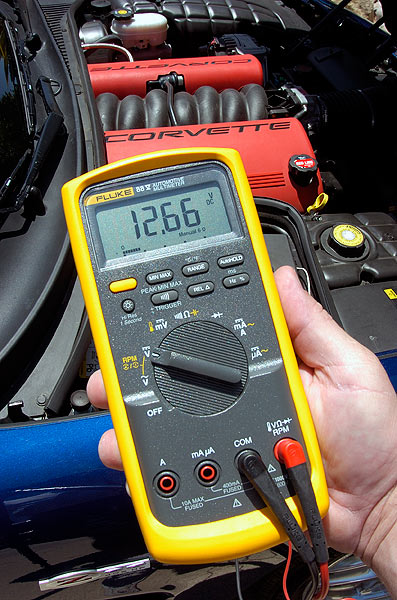
Click image for larger view
Our favorite DMM? The 88-V, shown here measuring battery voltage on an '04 Z06. We can't help it if we're spoiled by the Fluke's hefty feel, its ease of use, high-end professional features, durability seemingly measured in generations and a limited lifetime warranty.
Image: Author
On the downside, the 233/A will not measure RPM without Fluke's, optional inductive pick-up and it lacks the plethora of automotive-specific test leads which come in the 88 V/A kit. If you want a 233/A with the automotive testing capability approaching that of the 88 V, you need to include an automotive test lead assortment and an inductive pick-up for reading RPM costing about $175.
The overall prize in our informal DMM comparison goes to the 88V/A for its combination of high-end features, Fluke's reputation for accuracy and a mid-$450 price. Flukes are tough and dependable-don't do this at home, but our testing included dropping an 88V on the floor. It survived, no worse for wear. Buy a Fluke and you have a DMM for life and, because it's in the GM service tool catalog, you have the same diagnostic "muscle" dealers use.
 |
 |
